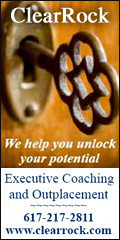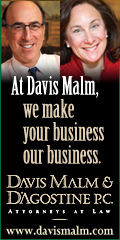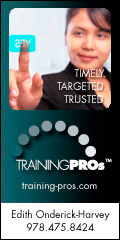NEHRA News
Northeast Human Resources Association
Before we get to the first focus area, I want to summarize what you might already know (or have some background in): the four distinct groups of employees that make up the work force today:
· Traditionalists (ages 67 – 90) are the smallest portion of the workforce. About 95% of the Traditionalists are retired from the workforce. Traditionalists tend to be loyal, respect authority and find technology challenging. They are loyal to country and company.
· Baby Boomers (ages 48 – 66) are currently the largest living generation with about 51 million people currently in the workplace. They are often described as skeptical workaholics that tend to question authority. Boomers are loyal to themselves and family (and company third).
· Generation X (ages 31 – 47) is a highly adaptable generation making up about 41 million of our workforce. Gen X employees tend to be somewhat cynical; they value work-life balance, think globally and are unimpressed by authority. They are loyal to their family and their boss (significant shift in company loyalty).
· Gen Y, aka Millennials (ages 12 – 31) is growing and will soon be the largest portion of the workforce. They are characterized as optimistic team players with an enthusiasm for change and respect for authority. Gen Y is loyal to their social network and family.
Most of what is produced on this topic focuses equally on these generations with a particular emphasis on why it is so difficult bringing them together in the workplace. These three focus areas will help bring the generations discussion into a manageable dialog.
Focus on What is Ahead
According to the U.S. Bureau of Labor [1] estimates, Generations X and Y will be 103.6 million strong by 2014 while the Baby Boomer workforce population will fall to 47.6 million (no statistics were available for the much smaller Traditionalist workforce). The focus of business must be on hiring and retaining these three generations, with particular emphasis on Generation Y.
Generation Y will make up 39% of the workforce within two years. With a Baby Boomer retirement rate of almost 1.5% annually, it won’t be long before Generation Y’s size in the workplace increases even more. We can’t forget Gen X – their age group places them at the point in their careers to take on significant leadership positions. It’s easy to see how Generations X and Y will be the dominant workforce for a long time to come.
This is not to say we should ignore the other two generations. On the contrary, employees in the Baby Boomer and Traditionalist generations can be excellent mentors, and being mentored is highly valued by both Generations X and Y. It will be important for firms to leverage the strengths of these older generations to support and develop those that follow.
Focus on the Similarities
Studies suggest that there are three similarities shared by the four generations. Let’s examine each similarity:
Achievement
All generations have achievement in their list of characteristics. All want to do a good job, accomplish goals, and see the organization succeed. Contrary to the opinion of some of their Boomer work colleagues, Generation Y is very achievement oriented. Remember, this is the generation who took SAT prep courses, went to sports and band camps during the summer months, and longed for the sports trophy, even if the team lost!
Camaraderie
A sense of belonging is a key to employee engagement no matter the generation. While each individual is motivated by different levels of affiliation, a common denominator seems to be that they want to belong to something greater than themselves. They want to be proud of the organization they work for and be a part of its success.
Equity
The fairness issue rears its ugly head more often than we’d like, but equity for employees of all generations comes down to fairness in:
· Pay – this doesn’t mean they all have to be paid the same, just that there’s structure and fairness to the pay scale.
· Benefits – the days of the "executive" cafeterias and parking should be in the past. Employees of all generations oppose a class system within company benefits – even the Traditionalists know it is no longer an incentive to engagement.
· Opportunities to develop – all employees see themselves as potential candidates to grow and develop. For instance, recent studies tell us that Generation Y is three times more motivated by training opportunities than money.
Focus on Yourself
How do you adapt to the changing generations? Look at how you are addressing these three areas:
Turnover
Statistically, Gen Y employees stay around a whopping 18 months before searching for additional challenges. Once they leave, don’t underestimate the effect this has on their colleagues (the Pied Piper Effect). There are two ways to handle this:
1) Let employees "quit" their jobs but stay in the company via job rotations
2) When an employee does leave the company, stay in touch with the intention of bringing him/her back 18, 36 or even 54 months down the road. In other words, cultivate boomerang employees, don’t just hope for them.
Policies
Do you have an Internet policy? How about a phone policy? Is it against policy for someone to work at home? Generation X and especially Gen Y grew up on technology and will have a difficult time understanding a lack of flexibility in the policies that restrict the use of technology. Step back and take a look at what policies are preventing new employees from joining your company, or staying. Allowing your employees reasonable access to social media can be a significant branding, engagement and communication tool.
Promotions
I remember seeing a job posting for a Project Manager that said, "Must have 10 years with the company." We need to stop thinking in terms of age and years of experience and more in terms of behaviors, traits, and demonstrated abilities. Somebody from Generation Y may be perfect for the position, and if they aren’t considered, will look to go somewhere else. You should diminish tenure as a job requirement.
I’ve always believed in finding the common denominators in every topic. By focusing on future trends, similarities rather than differences, and your own flexibility, the challenges you face working with four generations can be more manageable and your solutions more effective.
Bob Kelleher in partnership with NEHRA will be presenting Typewriters to Tablets – Engaging the Generations on May 31 at the Forefront Conference Center. Join us for this engaging and interactive workshop with an emphasis on the X and Y Generations! And, don’t miss the opportunity to combine this workshop with our Disrupt – Recruiting and Branding in the Social Era.
Bob Kelleher, founder and CEO of The Employee Engagement Group, is a noted speaker, consultant, and author of LOUDER THAN WORDS: 10 Practical Employee Engagement Steps That Drive Results, and CREATIVESHIP: A Novel for Evolving Leaders. An in-demand industry speaker and thought leader, Bob spent 25 years working in the HR profession, most recently as Chief Human Capital Officer for AECOM. He can be seen or heard on national media (most recently on CNBC, CBS Radio, and Fox Radio); is a frequent guest writer on many national publications; and is a contributing editor on Boston.com, Monster.com, and Hotel Executive.
[1] All statistics used in this article are U.S. only.
One survey I conducted of 1,350 HR executives affiliated with the IMD Business School in Lausanne, Switzerland, revealed 54 percent of respondents thought their companies do an inadequate job of executive on-boarding.
In a more recent survey taken at The Conference Board, results were even worse, where 65 percent of HR executives at some 40 major companies thought their companies did a poor job of executive on-boarding.
So why do so many HR leaders believe their companies do a poor job transitioning newly hired executives? I believe it is due to a continued misconception about what "on-boarding" is and how best to implement an executive on-boarding system. A new-hire on-boarding program must address three imperatives: cultural adaptation, political connection and expectations alignment.
Imperative 1: Cultural Adaptation
Perhaps the most daunting challenge for a new hire is quickly adapting to an unfamiliar organizational culture. Doing this requires the on-boarding organization to communicate openly about its culture. This can be tough to surmount because some companies don't want to be open about their cultures for fear of scaring away talented recruits who may not see themselves as a match. Though often unconscious, this misdirection usually has harmful results. New hires either conclude they have been misled or they fail because they behave as though they are operating in one culture, when in fact they are dealing with a completely different one.
Imperative 2: Political Connection
Helping newly hired executives identify key stakeholders and forge relationships is the second on-boarding imperative. It's essential that transitioning executives develop the right "wiring" as soon as possible. There is a natural but dangerous tendency for new leaders to focus on building vertical relationships early in their transitions — up to their bosses and down to their teams. Often, insufficient time is devoted to lateral relationship building with peers and key constituencies outside their immediate organizations.
Ideally, the full set of key stakeholders is identified for the new executive before s/he formally joins the organization. A single point person (from HR) should identify a list of key stakeholders. They may also encourage and support the transitioning executive in setting up and conducting these critical early meetings.
Imperative 3: Aligning Expectations
Recruiting is like romance, and employment is like marriage. During the recruiting period, neither the organization nor the new hire gets a complete, clear view of the other. Both the leader and the organization put on their best faces, not necessarily to deceive, but to accentuate the positive. This is understandable, but it can sow seeds for potential problems later. The organization may come away with inflated expectations of what the new hire can accomplish. Likewise, the new hire may think he or she has more authority than really exists.
Aligning expectations is a prudent step to ensure the new hire doesn't take the mandate discussed during recruiting for granted. She or he should check and recheck expectations to ensure alignment in every case, and to identify opportunities for clarification and learning.
The On-Boarding Continuum
Attention to the three imperatives above alone is not sufficient. There should be a relationship between the recruiting and on-boarding processes. The best on-boarding processes can't compensate for the "sins" of poor recruiting. This disconnect is often exacerbated because different parts of the organization, with potentially divergent incentives, are responsible for recruiting and on-boarding.
One Transitions Framework
Finally, those entering a new role at every level should have a framework to guide them through the on-boarding process. Transitioning is a skill that everyone should have in their toolkit, much like project management or negotiation. An organization should embrace one framework for all transition types (on-boarding, promotion, departmental, geographic, new team, new structure or technology) at all levels throughout the organization.
Dr. Michael D. Watkins is the founder and Chairman of Genesis Advisers, a Newton, Massachusetts-based leadership development consultancy with an expertise in on-boarding and leadership transitions. Watkins is author of international business best-seller The First 90 Days, and will be the opening keynote speaker at the NEHRA Spring Conference this May 18 at the Four Points Conference Center in Norwood, MA. For a complete listing of conference events, and to register, visit the Spring Conference website by CLICKING HERE.
* All data in this article is from research conducted by Dr. Michael D. Watkins.
-
You will need to enter your primary email address as your Login Name. (Hint: This is the email we use to communicate with you). No idea what that is? Send us a quick message at info@nehra.com or call the office at 781-235-2900. We'll be happy to give it to you.
-
You will need to reset your password (Hint: Your new temporary password is Password1).
-
You will need to fill out some basic information (Hint: this will only take a minute and will help us better serve you in the future with targeted communication and programming).
Ready to get started? Here are some quick links:
Want to join NEHRA for the first time? Click here
Want to Login? Click here
Want to renew your membership or have a pending transaction with us? Click here
Want to register for an event? Click here
Want to post a job on our job board? Click here
If you run into any trouble, email us we're here to help! info@nehra.com
BoardProspects is pleased to invite NEHRA members to participate in BoardProspects’ exclusive beta program. As an early adopter, members will receive a one-year premium membership to BoardProspects.com for free. Please take a minute to visit BoardProspects.com/NEHRA to pre-register today.
BoardProspects’ Beta program captures interested prospects and boards via email registration. As an early adopter, you will be kept informed of our progress as we add functionality in preparation for our "go live" date this spring.
Find the right board for your management team.
Contact Becky Dowd:
Becky@BoardProspects.com
339-364-0061
BoardProspects also offers corporate membership discounts and opportunities for corporate sponsorships.
For more information or to sign up for this opportunity, contact the NEHRA office today at (781) 235-2900 or via email at info@nehra.com.



